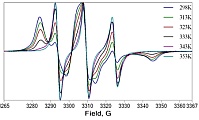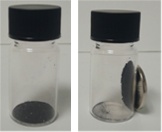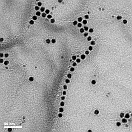Professor Victor Chechik
01904 324185
E-mail: victor.chechik@york.ac.uk
Mechanistic chemistry of free radicals, EPR spectroscopy and functional nanoparticles
The research in the Chechik group involves detecting and studying free radical intermediates, using stable radicals as probes for supramolecular assemblies and nanostructures, and developing functional nanomaterials (e.g., for medicinal applications). We often use EPR spectroscopy in free radical research (we have three CW-EPR spectrometers operating at X- and Q-bands). Developing mechanistic understanding is often the driving force for our research, and we collaborate widely on mechanistic problems. Current projects include the following areas:
Free radical reactions and radical intermediates
Short-lived free radical intermediates play a key role in many important processes, including combustion, polymerisation, atmospheric reactions, catalysis and biological process. However, they are difficult to study as they are usually present at extremely low concentrations. We are interested in developing methodologies for detecting short-lived radicals. We have recently developed a new type of radical traps for detection with mass spectrometry. We are using these traps (as well as more conventional spin trapping approach and EPR spectroscopy to understand the mechanisms of radical reactions. We are also interested in using We study free radicals in collaborations with atmospheric chemists, plasma physicists, materials chemists, and industry.

We are working on the development of electrical sensors for free radicals as a partner of the RADICAL project.
EPR studies of nanostructured materials
Although most free radicals are extremely reactive, some are very stable. Well known examples of stable radicals include molecular oxygen and nitrogen oxides (NO, NO2). Organic stable free radicals are excellent probes for studying complex systems (such as gels, nanoparticles, colloidal solutions, lipid bilayers, host-guest complexes etc) with EPR spectroscopy, as only the signals of the radical probes are observed. The EPR spectra provide wealth of information about molecular structure and organisation, local polarity, reactivity in these systems.


Vanadyl-labelled alginate gel and EPR spectra of a nitroxide-labelled gel
Magnetic nanoparticles for therapeutic delivery
Magnetic nanoparticles (e.g., with an iron or iron oxide core) bring together many properties of supramolecular systems. They can be easily functionalised with organic ligands that determine their solubility and other properties, several functional ligands can be attached to the same nanoparticle, they can be guided by static magnetic field and heated by oscillating magnetic field. We are interested in using these materials for medicinal applications. In particular, we work on developing functional organic coatings for nanoparticles that would provide active targeting and delivery of therapeutic agents.


Magnetic nanoparticles
Other current projects in the Chechik group include application of EPR spectroscopy for studying charge carriers in semiconductor nanoparticles, and electroorganic radical chemistry.
Selected Recent Publications
- P. J. H. Williams, G. A. Boustead, D. E. Heard, P. W. Seakins, A. R. Rickard, V. Chechik, New Approach to the Detection of Short-Lived Radical Intermediates, J. Am. Chem. Soc. 2022, 144, 15969-15976.
- J. Debgupta, L. Lari, M. A. Isaacs, J. Carey, K. McKenna, V. Lazarov, V. Chechik, R. Douthwaite, Predictive removal of interfacial defect-induced trap states between titanium dioxide nanoparticles via sub-monolayer zirconium coating, J. Chem. Phys. C 2023, 127, 660-671.
- N. Vagkidis, J. Marsh, V. Chechik, The Role of Polyphenolic Antioxidants from Tea and Rosemary in the Hydroxyl Radical Oxidation of N-Acetyl Alanine, Molecules 2023, 28, 7514.
- L. Duff, H. Meakin, A. Richardson, A. J. Greener, G. W. A. Smith, I. Ocaña, V. Chechik, M. J. James, Denitrative hydroxylation of unactivated nitroarenes, Chem. Eur. J. 2023, 29, e202203807.

